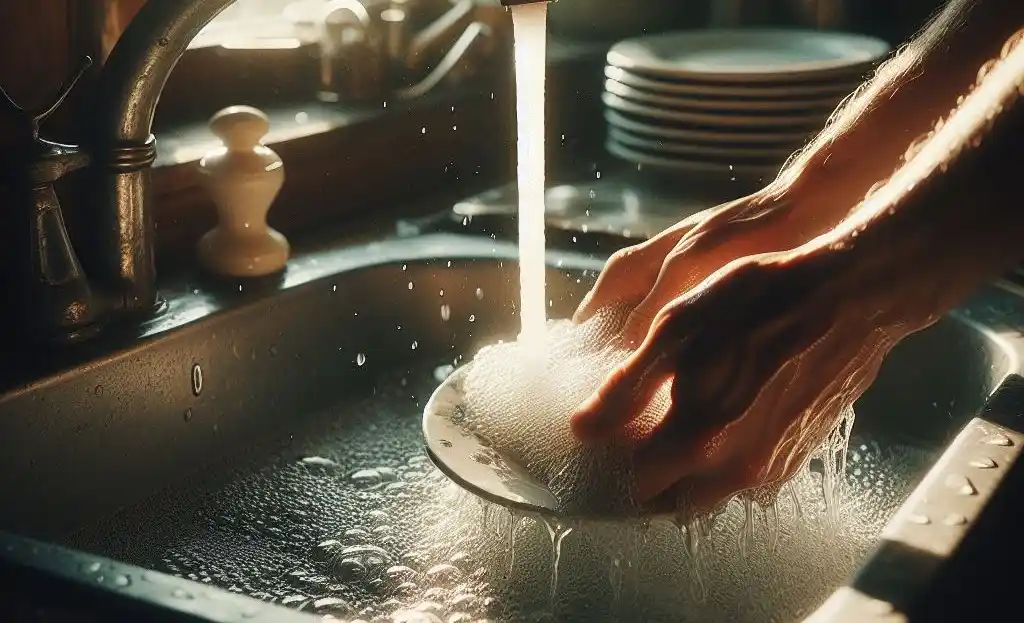Dishwashing Tips: How to Wash Dishes Fast in a Restaurant
Washing dishes in a busy restaurant kitchen is no easy task. With piles of plates, cups, and silverware to clean after every meal rush, dishwashers need to work quickly and efficiently to keep up.
This comprehensive guide covers everything you need to know about how to wash dishes fast in a restaurant. From optimizing your workflow to choosing the right tools and products, you’ll learn pro tips and best practices for getting spotless dishes fast.
Whether you’re a new dishwasher looking to step up your game or a kitchen manager trying to improve dishwashing operations, use these techniques to get sparkling clean dishes in less time. Let’s dive in!
Why Speed and Efficiency Are Crucial For Restaurant Dishwashers
Before we get into the nitty-gritty details, it’s important to understand why working quickly matters in a commercial kitchen. Here are three key reasons:
- Handle high dish volume: The average restaurant meal generates about 1.5 dishes per guest. For a busy establishment serving hundreds of covers a day, dishes pile up fast. You need to work efficiently to keep up.
- Free up prep space: Clean plates, pans, and utensils need to be put back into circulation so cooks have what they need to prep upcoming orders. Leaving dirty dishes in the sink bogs down the whole line.
- Improve customer experience: Having to constantly ask servers to bring more silverware or coffee cups reflects poorly on the restaurant. Swift dishwashing keeps supplies well-stocked so dining rooms run smoothly.
In other words, being an effective dishwasher directly impacts restaurant success. It’s one of the most critical roles on staff. Now let’s look at how to do it right.
Step 1: Sort and Rinse as You Go
One key to faster dishwashing is preparing dishes before they even go into the machine. Instead of letting them pile up, take a few minutes throughout your shift to:
- Sort cutlery and small wares: Set aside cutlery, cups, prep bowls, delicate glassware, and anything that requires special handling. Grouping similar items saves time later.
- Scrape and rinse: Use a spray nozzle, bus tub faucet, or sink sprayer to remove leftover food debris. This prevents clogs in the dish machine and removes stuck-on gunk.
- Soak pots and pans: Fill a bus tub with hot, soapy water for heavily soiled pots, pans, and bakeware to soak in. This loosens burned-on food for quicker scrubbing.
Staying ahead of the influx of incoming dishes reduces effort later. You won’t waste time hand-scrubbing dishes before racking them.
Step 2: Set Up an Assembly Line Rack System
Commercial dishwashing machines use multi-level rack systems to wash and rinse large batches of dishes at once. Setting up an efficient loading and unloading assembly line is crucial for achieving speedy results.
Follow these assembly line best practices:
Use Color-Coded Racks
- Assign specific color racks for clean versus dirty dishes
- Reserve one color for dirty items going into the machine
- Use another color for clean items coming out of the machine
- Keeps clean and dirty dishes completely separate
Load Strategically
- Place plates upright along rack shelves
- Stack bowls inside each other
- Balance glasses rims down into slots
- Load cutlery into dedicated cutlery containers
- Make sure water reaches every surface
Unload in Stages
- Empty the bottom rack first, then the middle, then the top
- Transfer dishware directly to storage areas
- Rinse each rack as you unload it
- Send back for the next batch of dirty dishes
This smooth loading and unloading flow prevents bottlenecks. With an optimized rack system, the dishwashing process turns into an efficient, seamless machine.
Step 3: Choose the Best Dishwashing Tools
Having the right dishwashing tools makes cleaning faster and easier. Commercial kitchens need heavy-duty scrub brushes, scrapers, gloves, and aprons that can withstand hours of continuous use.
Here are the top tools every restaurant dishwasher should have:
- Steel wool scrub pads: Made of abrasive stainless steel, these pads power through caked-on food. Use them to scrub pots, bakeware trays, and heavily soiled dishes before running them through the machine.
- Brushes with angled handles: Ergonomic brushes allow you to scrub dishes at different angles while reducing wrist strain. Nylon and brass bristles stand up to grease and burns.
- Flat scrapers: Flexible plastic scrapers help gently lift food debris from flatware and dishes so you don’t have to use your fingernails or other sharp objects.
- Wire grill brick: This heavy-duty rectangular brick cleans tough grime on grill grates, broiler pans, baking sheets, etc.
- Dishwand: A dish wand combines a handle-mounted brush on one end with a soft scrubbing sponge on the other. It speeds up scrubbing glassware, cups, delicate items, and greasy spatulas.
- Heat-resistant gloves: Protect your hands from scalding-hot pots and pans fresh from the cook line. Chemical-resistant gloves also shield skin from harsh detergents.
Investing in high-quality dishwashing tools makes you more effective over long shifts. Plus quick access to the right tool for each job prevents wasting time rummaging around.
Step 4: Follow a Speedy Scrub Sequence

When tackling a large pile of dirty dishes, having a methodical scrub sequence helps you plow through them efficiently.
Use this speed scrub formula:
- Remove food debris – Scrape plates, shake out drinkware, and drain liquid from pots/pans into the garbage can.
- Soak/scrub – Soak burnt food residue in bus tubs filled with hot soapy water. Use scrub brushes, steel wool, or wire grill bricks to remove stuck-on food.
- Rack – Strategically load dish racks according to your system (see Step 2).
- Wash – Send loaded racks through dish machine wash and rinse cycles.
- Inspect – Visually inspect each dish as you unload racks. Re-wash any items with debris or grease spots still on them.
- Stock – Transfer dishware directly to storage areas: plates/bowls on shelves, glassware/mugs in racks, utensils in drawers.
Repeating this reliable sequence trains your body and brain to work faster without missing any cleaning steps. Eliminating extra handling or backtracking keeps things moving speedily.
Step 5: Handle Special Items Carefully
Certain dishware and small wares require extra attention when washing by hand. Learn how to properly clean the following common items:
- Glassware – Submerge in warm soapy water to loosen drink residue before scrubbing inside surfaces. Rinse carefully checking for debris inside. Air dry glasses rims down to prevent breakage as moisture evaporates.
- Cutlery and smallwares – Use a cutlery container or magnetic wand to keep all pieces together during washing. Pay special attention to fork tines and knife edges when hand-scrubbing.
- Pots/pans – Knock out dried bits of food then soak in hot soapy water before scrubbing inside surfaces. Use steel wool on exterior burnt areas.
- China and delicate plates – Avoid abrasive scrub brushes/pads that can scratch surfaces. Check manufacturer instructions on whether items are dishwasher safe.
- Cast iron cookware – Hand wash gently then immediately dry and rub with a thin coating of vegetable oil to prevent rusting. Avoid using dish soap which removes seasoning.
Additionally, check with the health department about properly washing any items that touch ready-to-eat foods like cups, prep bowls, and cutting boards. High-heat dish machines may be required.
Handling these specialty wares carefully preserves them over repeated use while still removing all traces of food and grime.
Step 6: Restock Clean Supplies
One often overlooked part of the dishwashing job is replenishing “front of house” supplies that servers rely on. Make sure to regularly restock items like:
- Clean silverware
- Stacked plates, bowls, side plates
- Cups, mugs, glassware
- Butter dishes, condiment caddies
- Salt & pepper shakers, sugar bowls
This allows servers to swiftly reset tables after busing without needing to ask the dishwasher or enter the kitchen. Your work enables the whole dining room flow to run smoothly.
Step 7: Stay Ahead of Meal Rushes
The key to surviving relentless meal rushes is meticulous preparation before the chaos hits.
Use slower periods between services to:
- Fill soak tubs for heavy pots and bakeware
- Assemble rack setups so you can load and unload quickly
- Stage an arsenal of clean scrub brushes, steel wool pads, aprons, and gloves nearby
- Restock soap, sanitizer, drying towels
- Tackle difficult burnt pan bottoms needing extra elbow grease
- Ensure dish area floors are clean and non-slip
When you foresee the impending rush, you stay cool, collected, and ready to cleanly plow through piles of dishes.
How to Wash Dishes Fast in a Restaurant – Solution

In the frantic dance of a busy restaurant, the dishwasher plays a crucial role. Dishes pile up, time ticks by, and clean plates mean happy customers. But speed alone isn’t enough. Restaurant dishwashing demands E-A-T: expertise in handling diverse grime, authoritativeness in upholding hygiene standards, and trustworthiness to ensure every plate leaving the wash station is sparkling safe.
So, how do restaurant dishwashers achieve this holy trinity of clean? Here are some insider tips, distilled from years of scrubbing and sanitizing:
Expertise in Speed Demons:
- Master the Station Flow: Every second counts. Organize your space for swift scraping, pre-rinsing, and loading racks. Develop muscle memory for the most efficient movements, like stacking plates in a balanced way or using spray nozzles at optimal angles.
- Befriend the Beast: Commercial dishwashers are your allies. Learn their cycles, cleaning agents, and proper loading techniques. Pre-soaking stubborn pots in a designated sink can shave off precious seconds later.
- Tame the Grease Gremlins: Oil and grease cling like desperate diners. Pre-treat greasy pans with a specialized degreaser before hitting the hot water. A dedicated spray gun can be your secret weapon for blasting away baked-on gunk.
Authoritativeness in Hygiene Heroes:
- Temperature Tango: Hot water is your best friend, but too hot can damage dishes. Know the ideal temperature range for your dishwasher and ensure consistent, scorching cleanliness. Remember, proper sanitization is non-negotiable.
- Chemical Champions: Dishwashing detergents are powerful allies, but misuse can breed disaster. Follow manufacturer instructions to the letter, avoiding mixing chemicals and over-sudsing, which can leave residue and affect sanitation.
- The Gloves of Glory: Wearing the right gloves protects your hands and maintains hygiene. Change them regularly, especially after handling raw meat or heavily soiled dishes. Remember, clean hands mean clean dishes!
Trustworthiness in Every Sparkle:
- The Final Inspection: A quick glance isn’t enough. Develop a keen eye for spotting missed food particles, streaks, or watermarks. Don’t let a single imperfection leave your station. Remember, your vigilance safeguards diners’ health and satisfaction.
- Maintenance Matters: Report any equipment malfunctions or worn-out brushes promptly. A well-maintained dishwasher is a fast, efficient dishwasher. By taking ownership of your station, you build trust in your skills and commitment to hygiene.
- Communication is Key: Keep the kitchen informed about the flow of dishes. Let them know if unexpected delays arise or if you need immediate support. Clear communication builds trust and ensures the entire restaurant runs smoothly.
Remember, washing dishes in a restaurant isn’t just about speed. It’s about expertise in tackling grime, authoritativeness in upholding hygiene standards, and trustworthiness in ensuring every plate meets the highest safety and cleanliness expectations. By mastering these E-A-T principles, you become more than just a dishwasher; you become the silent guardian of the kitchen, ensuring every meal served is as sparkling as the plates it arrives on.
Bonus Tip: Share your knowledge! Train new dishwashers, mentor colleagues, and contribute to improving your kitchen’s dishwashing processes. By sharing your expertise, you build a culture of E-A-T that benefits everyone – from the chefs to the customers.
So, go forth, dishwashing warriors! Let your efficiency become your legend, your hygiene your badge of honor, and your trustworthiness the reason every plate shines brighter than the last. After all, in the symphony of a busy restaurant, the dishwasher plays a vital, sparkling note.
Pro Dishwashing Tips and Shortcuts
Veteran dishwashers employ all sorts of time and effort-saving tricks they’ve learned over thousands of shifts.
Check out these smart hacks:
- Immediately remove labels on new dish bins, food storage containers, etc. before debris sticks underneath
- Soak cutting boards used for raw meat separately to avoid cross-contamination
- Fill a labeled spray bottle with a degreaser like Simple Green for quick cleanup during shifts
- Stash extra towels for unexpected messes or dripping clean racks
- Place floor mats at key stations to improve comfort and reduce back issues
- Streamline workflow by only turning on the dish machine when full racks are ready to run
- Play high-tempo music to power through intense shift periods
- Use mental tricks like timed challenges to push washing speed
Finding little shortcuts here and there shaves off seconds and minutes that really add up when washing dishes nonstop. Test out different ideas that streamline your specific dishwashing operation.
Top Dishwashing Products Commercial Kitchens Rely On
Using commercial-grade detergents, sanitizers, drying agents, and degreasers takes cleaning efficacy and speed to the next level.
Look for these essential dishwashing products used in restaurants:
- Machine detergents – Highly concentrated formulas dissolve grease, emulsify food residue, and prevent hard water spots without hand pre-rinsing. Brands like Solid Power XL are specially formulated for commercial dishwashers.
- Rinse aids – Greatly improves drying action by allowing water to sheet off smooth surfaces. Prevents sticking and staining.
- Degreasers/descaler – Loosens burnt-on carbon deposits and grease buildup. Soaking pots and pans regularly in degreaser keeps machine filters cleaner.
- Deliver – Removes scale and mineral buildup from dish machines which compromises cleaning performance.
- Sanitizers – Kills 99.999% of foodborne illness-causing germs like E. coli and Salmonella. Look for machine detergents containing built-in sanitizers like Solid Power XL to replace separate sanitation steps.
- Drying agents – Polishes stainless steel surfaces and assists air drying through sheeting action. Helps prevent water spots.
For best results, use products designed specifically for commercial dish machines and high-temperature sanitization. Brands like Ecolab, Solid, and Carrolls offer training on setting up an effective dishwashing program.
The Importance of Proper Dish Machine Operation
Using commercial-grade detergents, sanitizers, drying agents, and degreasers takes cleaning efficacy and speed to the next level.
To ensure proper operation:
- Test water temperature regularly to verify temps satisfy health code sanitization minimums
- Check chemical titration levels match product specifications
- Descale hard water buildup and decline softened water deposits
- Clean dish machine filters nightly to keep spray arms functioning correctly
- Ensure adequate airflow for drying action & prevent mold/mildew from moisture
- Fix leaks immediately and schedule regular maintenance checks
Regular care optimizes performance. If machine components fail, hand washing piles of dishes is extremely time and labor-intensive. Technicians can also perform computer diagnostics assessing cycle times, GPM levels, backflow prevention, and error codes.
Well-running equipment is essential for quickly achieving sparkling clean results.
Dishwashing Best Practices Any Restaurant Can Implement
Beyond the standard operating procedures we’ve covered, adopting some key management best practices improves overall dishwashing operations:
- Use color-coded scrub brushes – Reserve brushes with green, red, and yellow handles for specific tasks like glassware, plates, and pots. Eliminates cross-contamination. Can match rack colors too.
- Install an overhead sprayer/faucet – Positioned strategically above a prep surface, these powerful sprayers speed up rinsing and soaking steps while conserving water.
- Lower machine racks 2”- 3” – Adjusting rack height helps tilt dishes for better water flow coverage and decreases rack jamming issues.
- Install machine booster heaters – Supplemental heaters increase wash temperatures for enhanced grease cutting and sanitization.
- Optimize timer settings – Technicians can tweak cycle durations so each stage lasts only as long as necessary for that kitchen’s water pressure, soil loads, etc. Saves water, energy, and time.
- Ensure accurate machine gauges – Gauges measuring PSI, GPM, temps, etc. impact cycle programming. Inaccurate gauges throw everything off.
- Consider heated air dryers – External blowers circulate 170°F+ air for fast, spot-free glass and flatware drying without hand polishing. Big water and energy saver.
- Train new dishwashers – Set clear expectations for quality and speed standards. Review sorting, loading, and scrubbing protocols. Share pro tips and tricks.
Adjust equipment, tools, layouts, and standard operating procedures to help your dishwashing staff work smarter.
Key Takeaways on Washing Dishes Fast in Restaurants
Being an awesome dishwasher requires methodical efficiency – not just elbow grease!
To recap, focus on:
- Pre-rinsing and continuous sorting
- Smart rack-loading strategies
- The right heavy-duty tools for each task
- Consistent speed scrub sequencing
- Careful handling of delicate wares
- Advancing preparation before the rush
- Implementing veteran dishwasher shortcuts
- Using commercial-grade detergents and sanitizers
- Proper machine operation and maintenance
- Management best practices like color-coding
Mastering these steps leads to faster, cleaner dishes every time.
FAQs
What’s the most important thing for washing dishes fast in a restaurant?
Efficiency is key, but it shouldn’t sacrifice hygiene or quality. Mastering your station flow, using equipment effectively, and prioritizing pre-treating stubborn messes will shave off seconds without compromising cleanliness.
What’s the ideal water temperature for dishwashing?
This depends on your specific dishwasher and detergent, but generally aim for hot water in the 150-180°F (65-82°C) range. Too hot can damage dishes, while too cool won’t effectively sanitize.
Do I need different gloves for different tasks?
Yes! Change gloves regularly, especially after handling raw meat or heavily soiled dishes. Consider having separate pairs for scraping, washing, and sanitizing to maintain optimal hygiene.








